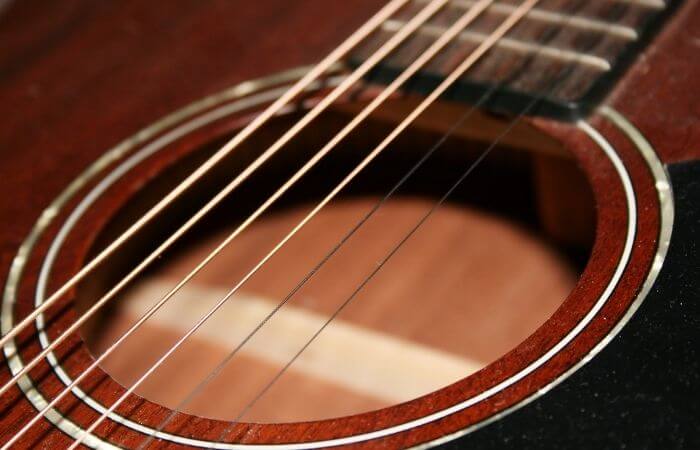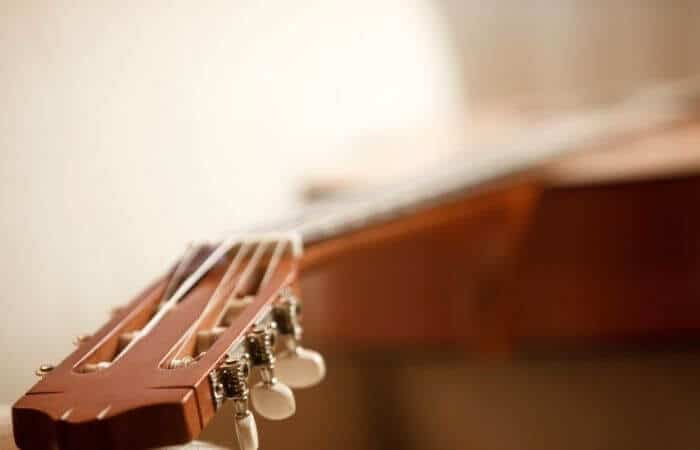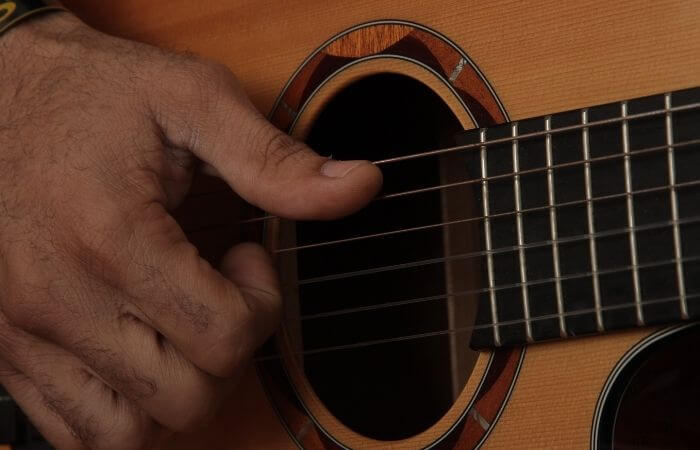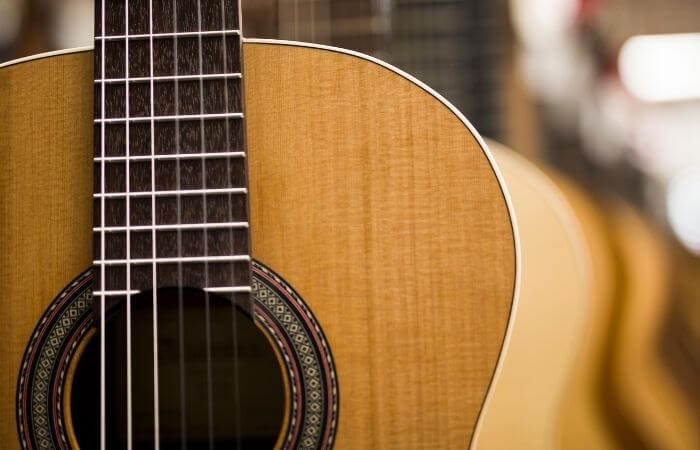To become a competent guitar player you need to practice lots.
If you’re the parent of small children or you live in a small apartment then noisy, energetic practice sessions aren’t really an option.
Fortunately, there are plenty of ways you can make your acoustic guitar quieter so that you can get your practice in without disturbing everyone.
Here are 8 methods you can use:
1. Fill The Soundhole
When you pluck an acoustic guitar vibrations travel through the strings into the neck and bridge and then into the body of the guitar.
The soundwaves then resonate around inside the soundhole, increasing in volume and thus amplifying the sound.

By filling the soundhole you reduce the space that the soundwaves have to resonate in and the soft fabrics you put inside will also dampen a lot of the soundwaves as they hit it.
Filling the soundhole is easy, just take a couple of t-shirts, tea towels or any soft fabrics you can find and carefully stuff them in there.
The more fabric you use the greater the dampening effect will be..
..just remember to take them out before you go and perform your next gig!
2. Use A Feedback Dampener
Feedback dampeners are small rubber circles that fit into the soundhole covering it completely.
Feedback dampeners are a very effective way of quietening acoustic guitars because they do a great job of deadening the deeper bass soundwaves.
Sound vibrations which travel through your guitar into its body will not be able to travel out through the air in the soundhole, meaning your guitar will be much quieter.
Bass frequencies travel through walls and floors far more easily than higher frequencies so dampening these will make a big difference.
While you can buy purpose-made feedback dampeners you can use anything that covers the hole.
Tape an old CD or a piece of cardboard over the hole, it doesn’t matter what it is providing it fully covers the soundhole it will be effective.
3. Use an Acoustic Guitar Silencer
An acoustic guitar silencer is something softs which sits on the strings at the lower end of the guitar.
In all acoustic guitars the noise starts with the string vibrating and moving the air, these vibrations resonate and grow as they travel through the guitar.
With an acoustic guitar silencer, you are dampening the noise right at its source – the strings.

They dampen the vibrations in the strings before they travel through the rest of the guitar and are an even more effective guitar quietening method than feedback dampeners.
Again you could buy a purpose made acoustic guitar silencer but you can use anything soft that can be compressed under the strings.
A folded sock, a piece of foam, a sponge…any of these will work fine.
Just ensure that they are not super tight against the string or this will change the length of the string, they should sit softly against the string.
4. Tie something Soft Around The Neck Of The Guitar
An alternative and cheaper method which achieves the same effects as using a guitar silencer is loosely tying something around the neck of the guitar.
A sock, a scarf, a small towel, a hair tie, a handkerchief any of these will work fine.
Make sure when you tie them that they are sat loosely against the strings though as if it is too tight it will function like a capo (these are used for shortening string length to raise their pitch).
Doing this mutes the vibrations creating a far quieter sound.
5. Use Palm-Muting
Palm-muting is a method of quietening your acoustic guitar by placing the side of the hand on the strings as you play thus dampening the sound.

Palm-muting is a commonly used technique in various different styles of music from classical (to create a sound a bit like a bowed string instrument) to heavy metal (usually on an electric guitar).
To palm-mute, follow these steps:
- Place the little finger side of your strumming hand across the strings, just above the guitar bridge.
- Experiment with hand weight as you go, the more weight you apply to the strings the more the vibrations will be deadened and muted.
- Experiment with your hand positioning too. Keeping your hand close to the bridge will allow the strings to resonate more, moving your hand higher up the strings will deaden the noise more resulting in a more muted sound.
- As you play make sure your hand stays in contact with the strings at all times to keep it muted.
Obviously mastering this will take some practice but once you’ve got it mastered it can be a quick and easy way to get in some quiet acoustic guitar practice.
For more help with this check out this video on how to master the palm-mute.
Also Read:
How To Practice Violin Quietly
6. Pick With Your Finger Tips Not Your Nails
The fingernails vs flesh debate has raged on for years in the guitar world with many claiming that using your nails to pick creates a far stronger more aggresive sound and allows you to play a note faster whereas using your finger tips creates a more solid tone.
Regardless of which side of the debate you fall on it is well worth mastering both techniques so that you have more tools in your musical locker to use when needed.
In theory, picking your guitar with the soft flesh of your fingertips allows you to create a softer and (slightly) quieter sound.
Admittedly you can still make significant noise using your fingertips if you want to but it is easier to control the volume with your fingertips once you get used to how to do it.
7. Use Lighter Gauge Strings
Heavier strings have more mass so move more air and therefore creating deeper stronger vibrations that are louder and more disruptive.
If you are a finger picking guitarist then lighter strings are a must have if you want to save your finger tips to do things other than play the guitar.

Heavy strings are not only far noisier but far more painful to play too. Guitarists who use plectrums generally favour heavier strings as they are less prone to snapping
Switching your strings out from some extra light gauge strings will instantly quieten your guitar.
Be aware that this will create a far thinner sounding noise than thick strings do, but if it allows you to get some practice in during the evening while your kids are sleeping then perhaps the compromise is worth it!
8. Try A Travel Guitar
This isn’t a cheap option as it involves buying a whole new guitar, however, it is effective.
Travel guitars do not have the soundhole making them much more portable and almost silent.
They make as much noise as an unplugged electric guitar (not much at all).
Most travel guitars use what are known as stethophone headsets which allow you to hear the music you are playing more clearly, often without the need for batteries or any power source.
This means you can strum away in your hotel room at 2am as vigourously as you want and it won’t result in angry neighbors knocking on your door!
We hope these tips help you work out how best to get some guitar practice in without disturbing anyone.
If all else fails then you could try and soundproof a room specifically for guitar practice.
Check out our piece on how to soundproof a room for drums – if the soundproofing works for drums then we are confident it will work for an acoustic guitar too!
As an Amazon Associate I may earn a small fee from qualifying purchases at no extra cost to you. This helps us run the site, so thanks for your support!
